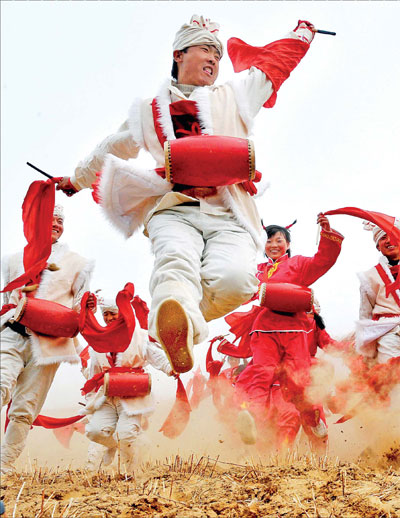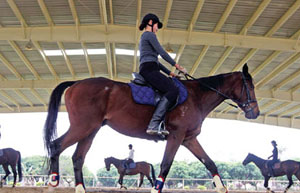Leading a song and a dance about heritage
Updated: 2011-12-13 10:11
By Kang Bing, Chen Liang and Ma Lie (China Daily)
|
|||||||||
Shaanxi province's Ansai county is a national base for the folk culture industry, which is experiencing both good and bad tidings. Kang Bing, Chen Liang and Ma Lie report.
 |
|
The Ansai waist drum dance has a history of 2,000 years and shows off the wild character of farmers on the Loess Plateau in Shaanxi province. Qi Xiaojun / Xinhua |
There is a famous scene in Chen Kaige's award-winning Yellow Earth of 150 people beating drums at a parade as the dust swirls around. It made the Ansai waist drum and dancers famous around the world. Based in Ansai county, Yan'an, Shaanxi province, they have performed at events ranging from celebrating the return of Hong Kong to China in 1997, and the 50th and 60th anniversaries of the founding of New China in 1999 and 2009.
Ansai waist drum dances date back 2,000 years and almost every village in the area has its own teams. But they are losing their traditional show grounds on the slopes and hilltops of the Loess Plateau because bushes and trees now cover the land following a 20-year arable land project.
The improved environment, changing lifestyles and fast economic development are having a mixed impact on the region's colorful cultural heritage.
Yan'an, because of its remoteness and poor transport, is rich in folk arts and customs, such as North Shaanxi folk songs, paper-cutting, dough modeling and waist drumming.
Peng Hui, deputy-director of Yan'an city's publicity department, says 104 items of intangible cultural heritage have been found in the city's 13 districts and counties.
More than 30,000 folk songs are still popular in the region, while tens of thousands of people can sing the folk songs or still do paper-cutting.
The United Nations Educational, Scientific and Cultural Organization (UNESCO) has named two of the region's folk artists as masters, while six folk artists have been named as national representative inheritors of intangible cultural heritage.
Of the districts and counties in Yan'an, Ansai is known best for intangible cultural protection. So the Yan'an government has been building Ansai into a national base for the folk culture industry.
Until the early 1990s, Yan'an was one of the most impoverished regions in Shaanxi. But in 2000, the area's GDP per capita started leading the province because of oil and coal production. In 2010, its GDP per capita amounted to 40,000 yuan ($6,300) per year, surpassing many major cities.
"More rural people, especially the young, have moved into towns and cities. They certainly favor TV and the Internet instead of traditional recreation, such as singing folk songs and watching traditional folk operas," says Ansai government publicity department head Qu Yongfeng. "Some of our folk art forms are losing their fan bases."
Wang Xi'an, one of Ansai's master paper-cutters, says that her works used to decorate cave dwellings' windows for weddings or during traditional festivals.
"I gave my neighbors my paper-cuttings and they sent me a bowl of stewed pork, a cabbage or two cucumbers in return," she says. "Now my paper-cuttings are mainly for outsiders. And few people now live in cave dwellings here."
The majority of folk art masters are elderly. Paper-cutting artist Gao Jin'ai - one of two national representative inheritors of intangible cultural heritage in the county - passed away at 89 in 2010.
"That was a blow to our heritage protection," Liu Zhanming, vice-director of Ansai's culture bureau, says. "We are trying to promote Wang Xi'an as our new national representative inheritor for the art of Ansai paper-cutting but have to wait at least two years for State approval."
Local governments in Yan'an have paid particular attention to heritage protection and are trying to popularize it with money from the mining and energy industries.
Qu Yongfeng says Ansai government has spent 1 million yuan ($157,000) on awards to folk artists who have won prizes at various national or provincial competitions since 2006.

The first-prize winner of a national competition will get 8,000 yuan, and the first-prize winner of a provincial competition will get 6,000 yuan, Qu says.
Since 2003, Ansai's government has added the county's four major folk art forms - Ansai waist drumming, paper-cutting, farmer painting and folk singing - to the curriculum of art and music classes in the county's primary and secondary schools.
In 2008, this initiative was expanded to Yan'an city's primary and secondary schools.
"We hope to pass down our intangible cultural heritage to a younger generation in this way," Ansai No 2 Primary School's principal Wang Jinling says.
Every July, Liu Zhanming says, Ansai Mass Art Center holds an annual paper-cutting training course for young enthusiasts from the countryside.
"The one-week or two-week courses teach 40 to 50 participants not only paper-cutting, but also farmer painting," he says. "Many of them go on to become professional folk artists."
Chen Haili, Chen Lianlian, Du Huan and Guo Banzhuan have taken part in the training courses. Early this year, the four women, all younger than 30, opened a paper-cutting and farmer painting workshop at a residential building on the county town's main street.
They all come from nearby villages and have been studying paper-cutting since childhood. They have won awards at paper-cutting and farmer painting competitions and are passionate about their profession.
They charge 200 yuan for an album of small paper-cutting works, 200 yuan for a larger sized paper-cutting, and 500 to 600 yuan for a farmer painting.
"We can afford the rent of 10,000 yuan a year and still make ends meet," Chen Haili says.
As the head coach of Ansai county's waist drum dance team, Liu Zhanming has been to the United States, Peru, Japan, France, Germany, Italy and Thailand, with his more than 40 drummers.
"All of our team members are from villages and most of them are middle-aged," Liu says. "They have both strength and experience."
The 73-year-old Cao Huairong, who is the county's only national representative inheritor of Ansai waist drum dances, performed for former Chairman Mao Zedong when he was 8 years old, and did so again for President Hu Jintao in 2006.
Even though he is too old to travel abroad and perform these days, he can still dance well enough to teach more than 30 routines to his 10 grandsons and six granddaughters.
For this, the State gives him 8,000 yuan a year.











